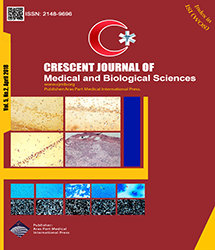| Original Article | |
| The Association of Energy Intake and Expenditure, Macronutrients, Glycemic Index and Load, and General Characteristics With Postprandial Peptide YY 3-36 Serum Levels | |
| Maryam Rahemi1, Mohmmad Alizadeh2 | |
| 1Student Research Committee, Urmia University of Medical Sciences, Urmia, Iran 2Department of Nutrition, Food and Beverages Safety Research Center, Faculty of Medicine, Urmia University of Medical Sciences, Urmia, Iran |
|
|
CJMB 2018; 5: 107-114 Viewed : 3781 times Downloaded : 3286 times. Keywords : Diet, Glycemic index, Glycemic load, Meals, Peptide YY |
|
| Full Text(PDF) | Related Articles | |
| Abstract | |
Objectives: This study set out to determine the association between dietary intakes at lunch and postprandial peptide YY 3-36 (PYY3-36) 90-120 minutes after the consumption of lunch meal. Materials and Methods: In the present cross-sectional study, the subjects (n = 176) were asked to eat their lunch at work on the test day. The postprandial concentration of PYY3-36 was measured 1.5 to 2 hours after the consumption of lunch meal. Results: The subjects within the age range of 25 to 39 and those with ages less than 25 (P = 0.005) indicated the highest and the lowest levels of PYY3-36, respectively. Postprandial PYY3-36 had a direct significant association with fat content at lunch (P = 0.049) and had an inverse association with cholesterol (P = 0.001), docosahexaenoic acid (DHA) (P = 0.040) and eicosapentaenoic acid (EPA) (P = 0.022). Moreover, polyunsaturated fatty acids (PUFAs) and linoleic acid at lunch indicated a significant positive correlation with PYY3-36 (r = 0.182, P = 0.016 for both). Furthermore, a significant negative correlation was detected between energy intake at dinner and post-lunch PYY3-36 (r = -0.216, P = 0.004). Protein (OR [odds ratio] = 0.390, 95% CI: 0.160-0.950) and fat intake (OR = 2.697, 95%CI: 1.103-6.594) at lunch, energy intake at dinner (OR = 0.298, 95% CI: 0.127-0.702), and energy spent to perform physical activities after lunch (OR = 0.411, 95% CI: 0.182-0.929) significantly predicted the serum concentration of post-lunch PYY3-36. No significant association was found between PYY3-36 and glycemic index and load. Conclusions: There was a significant association between dietary intakes at lunch meal and post-lunch serum concentration of PYY3-36. Further large-scale cross-sectional researches and randomized controlled trials are needed to confirm the mentioned results. |
Cite By, Google Scholar
Online Submission System
 CJMB ENDNOTE ® Style
CJMB ENDNOTE ® Style
 Tutorials
Tutorials
 Publication Charge
Medical and Biological Research Center
About Journal
Publication Charge
Medical and Biological Research Center
About Journal
Aras Part Medical International Press Editor-in-Chief
Arash Khaki
Deputy Editor
Zafer Akan


















